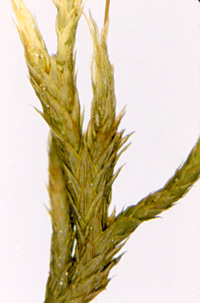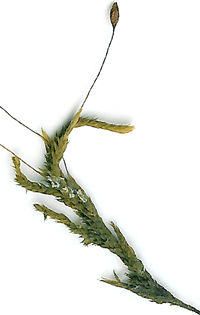
HEDWIGIACEAE
Braunia
Efrain De Luna, web page
Biodiversidad y Sistemática, INECOL. Xalapa. México
|
Hedwigia Pseudobraunia |
|
Braunia secunda (Hook.) Bruch & Schimp. Bryol. Eur. 3 (fsc.29-30): 161. 1846. Hedwigia secunda Hook., Musci Exot. 1: 46. 1818; Neckera secunda (Hook.) Müll. Hal., Syn. Musc. Frond. 2: 103. 1851. Protologue. "In regni Mexicani montosis apricis, juxta Toluccam ad pedem montis perpetua nive obtecti, regione frigida, altitudine 9840 pedum". Type: México, Nevado de Toluca, Humboldt & Bonpland s. n. (isotypes, herb. Hampe-BM!, herb. Hookerianum-BM!, NY!). Braunia secunda var. crassiretis Thér., Smiths. Misc. Coll. 78(2): 24. 1926. Type: México, vicinity of Morelia, Campanario, 2200 m., Nov. 1911, Arséne 7448 (holotype, US!; isotypes, BM!, F!). not Hedwigia secunda Grev. in herb. Hampe. Anoectangium secundum Mont. [= Braunia macropelma (Müll. Hal.) A. Jaeger] |
|
Description. Plants medium-sized in dense mats; stems with sympodial branching, plagiotropic, (3–)4–5(–6) cm long, scarcely branched; branches short, erect; flagelliform branches rare; pseudoparaphylia foliose, with papillose cells. Leaves ovate or ovate-lanceolate, widest point below middle of leaf; acumen gradually differentiated, to 1/4 length of leaf, short acuminate, concolorous, 1.9–2.2 × 0.8–1.1 mm, leaf lamina flat or slightly concave, imbricate, erect-patent when dry, spreading when moist, weakly plicate; margins revolute from base up 3/4 the leaf length, erose-dentate or scabrous at acumen; apical leaf cells 18–28 µm long, elliptic, mixed short (3–4:1) and elliptic (5–7:1), sinuose, with few low marginal papillae; upper and median leaf cells (12-)14-20(22) mm long, rectangular (3–5:1), walls nodulose, sinuose, papillae low, on side walls, overarching lumina. Paroicous. Archegonia distal on long vaginula (1.4–1.6 mm); perichaetial leaves oblong lanceolate, 2.4–2.6 mm long, slightly longer than vegetative leaves, acuminate, plicate; perichaetial paraphyses biseriate at base, 2–3 times longer than archegonia, immersed. Setae (5–(9–14)–20) mm long; capsule exserted, necks 0.3–0.4 mm long, gradually differentiated, slender, urns 1.2–1.6 mm long, cylindrical, mouth narrow, nearly as 1/2 the urn width, capsule walls smooth, or wrinkled when dry, exothecial cells polygonal; stomates superficial; opercula base conical, short oblique rostrate. Calyptrae cucullate, large, hairy. Spores unicellular, 35–42 µm in diameter.
Habitat. This species has been collected on rocks, forming carpets on exposed volcanic rocks (rarely on soil). It is very common in coniferous and broadleaf forests at middle elevations (1400–2500 m).
Distribution. USA, Mexico, Guatemala, Venezuela, Dominican Republic and Haiti.
Illustrations.
Selected specimens examined.
USA (Arizona: Bartram 617, BM!; Texas: Muller c4a, BM!),
Mexico (Pringle 25a, BM!, JE!, S!), Guatemala (Standley 85253, NY!), Venezuela (Griffin & Duarte 1143, H!, FH!, FLAS!, MICH!, NY!), Dominican Republic (Buck 14174, NY!), Haiti (Türckheim, 1910, H!). Paroicous stems are a character that clearly circumscribe this species. Other characters that distinguish B. secunda are the nearly flat, narrowly lanceolate leaves, with margins strongly revolute up to acumen. The apex is acuminate, scabrous dentate, with oval and elliptic apical cells. Also the perichaetial paraphyses are frequently exserted and the capsules are ellipsoid, inflated at the base and slightly constricted below the mouth. The capsule wall is irregularly wrinkled when dry. This is a much narrower circumscription than conventionally accepted (Brotherus 1925; Dixon 1920). It does not include populations distributed in Africa and India. However, in Mexico it is still difficult to separate sterile material of Braunia squarrulosa, H. integrifolium and B. secunda as discussed by Sharp et al (1978). Leaf margins are revolute up to the acumen in B. secunda and H. integrifolium but the margin is revolute only at the base in B. squarrulosa. In Mexico, it is also difficult to distinguish gametophytes of B. secunda from B. andrieuxii and B. plicata. Leaves are broader, obovate and the upper leaf cells are shorter in the latter two species. Additionally, B. andrieuxii has the leaf margins erect or reflexed but only at the base. On the other hand, B. plicata has strongly plicate leaves with a broad, hyaline, strongly papillose, and dentate acumen. Braunia secunda as recognized here, is exclusively neotropical and commonly grows on rocks in forests at middle elevations (1500-2000 m). Specimens from Dominican Republic and Haiti are more robust than specimens from Mexico and Central America, and resemble B. cirrhifolia in the very narrowly lanceolate leaves, with long acuminate to piliferous apices, and long elliptic, strongly sinuous cells. Theriot (1926) was right indicating that the aereolation in B. secunda var. crassiretis was like that of B. cirrhifolia. However, the paroicous gametangia are absent in B. cirrhifolia. |
|
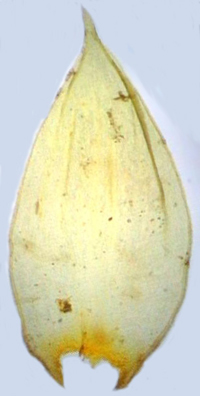 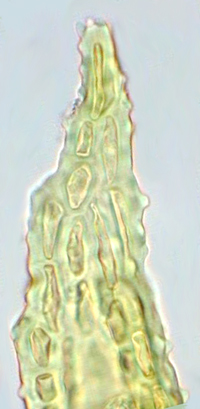 | |
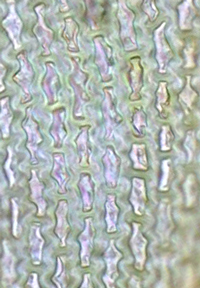 | |
Reference:
De Luna E. 2016. Typification, taxonomy, and worldwide distribution of Braunia secunda (Hook.) Bruch & Schimp. (Hedwigiaceae). JOURNAL OF BRYOLOGY 38: 286-294. PDF | |
distribution map updated Sept 2021 |
|
|
|
